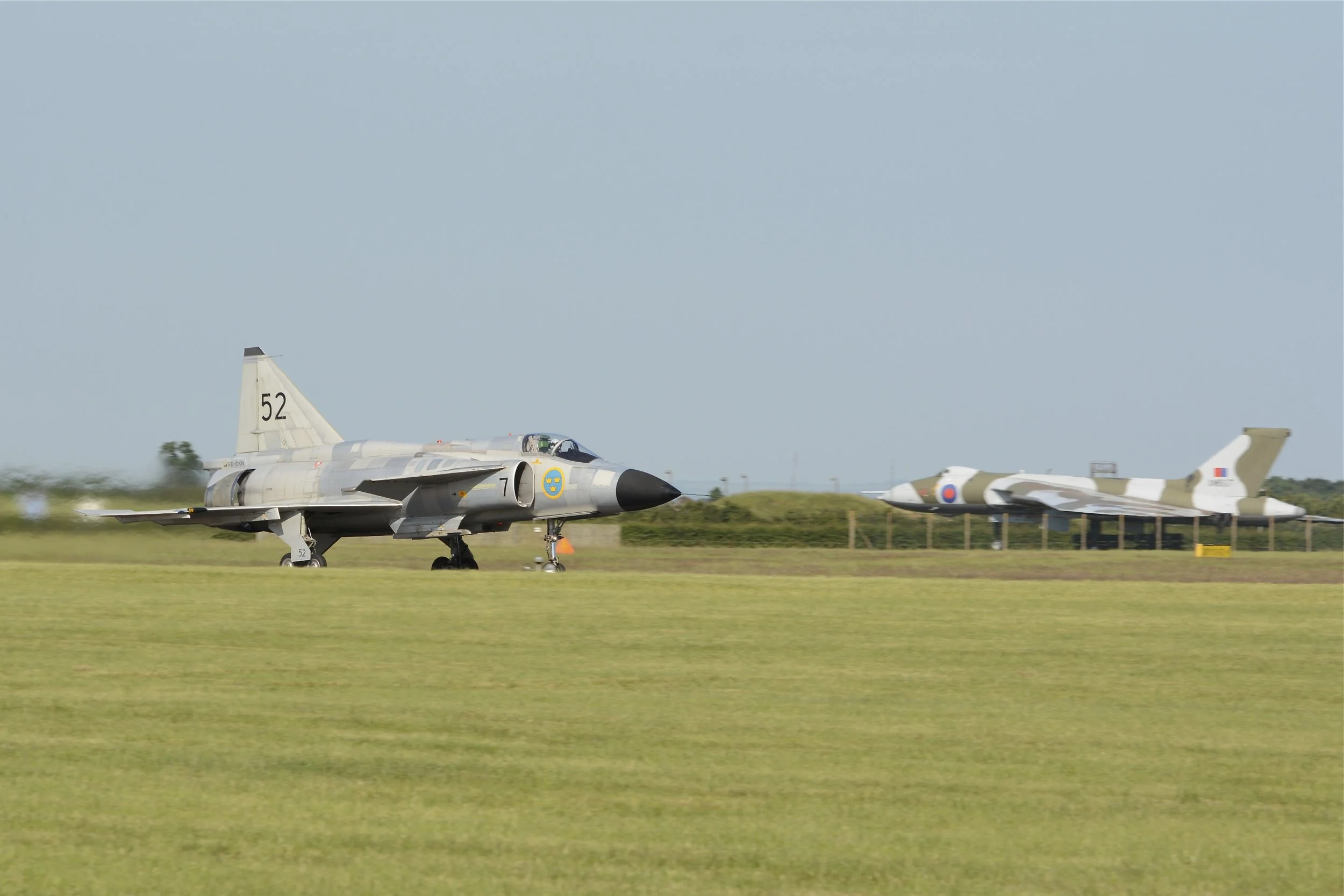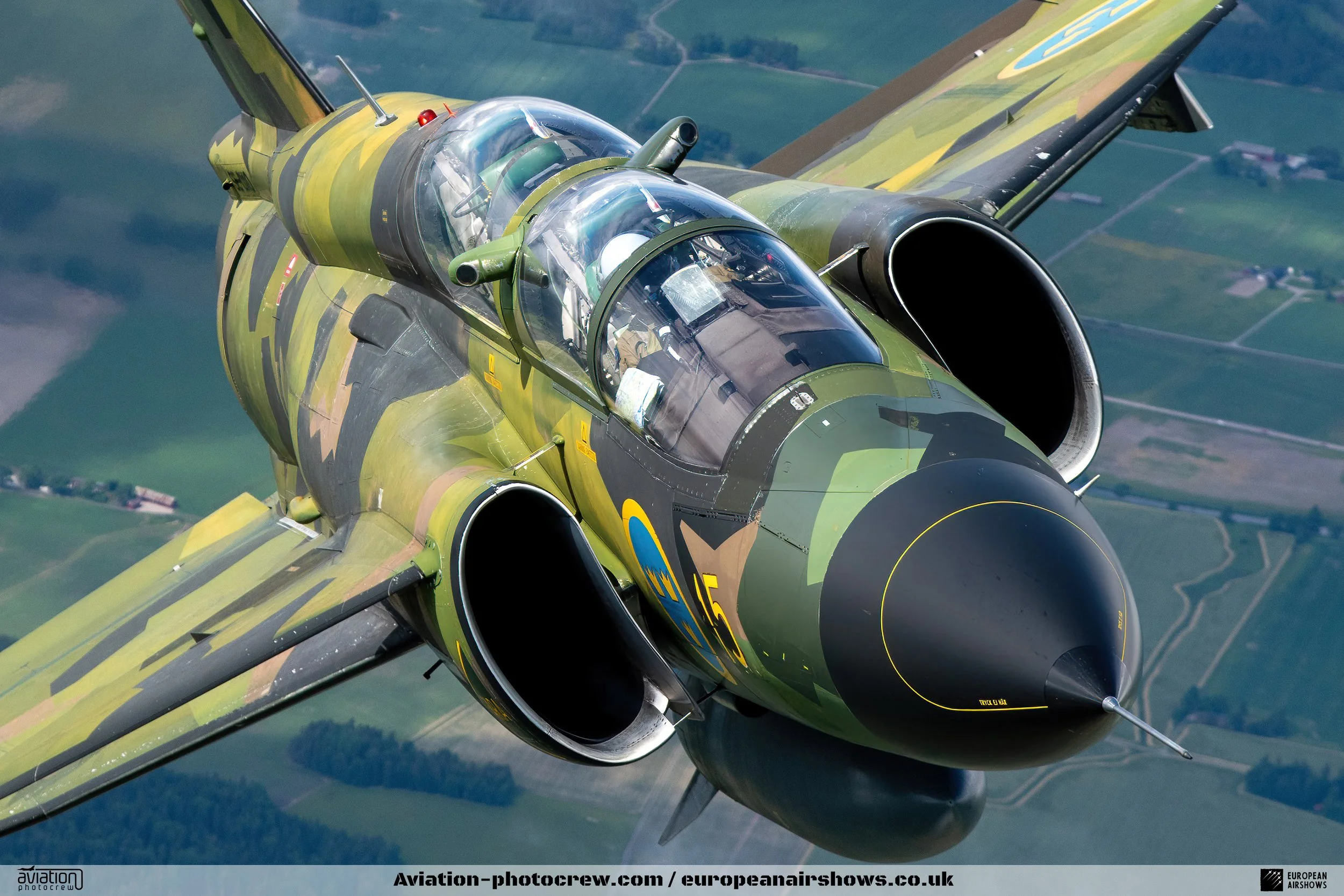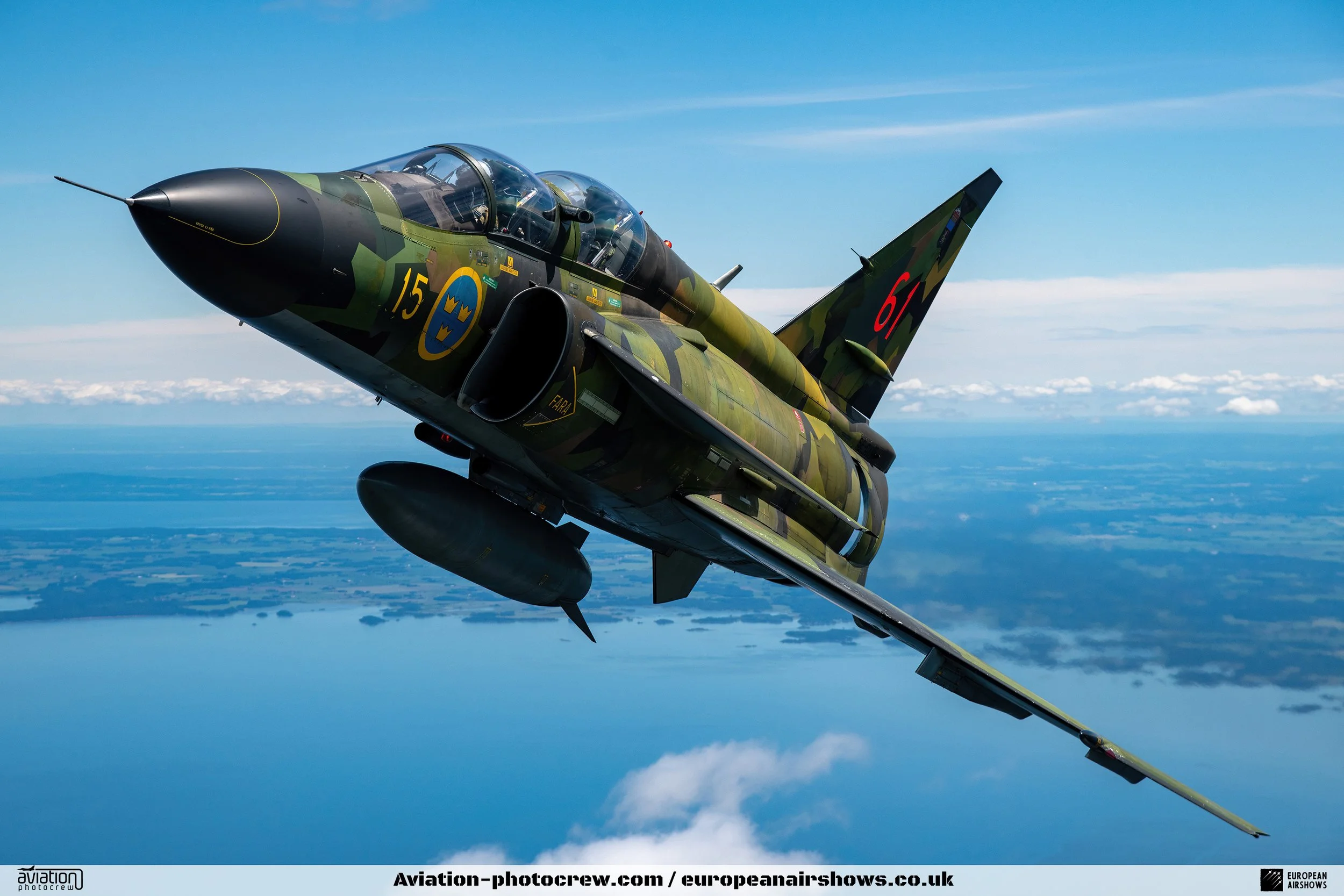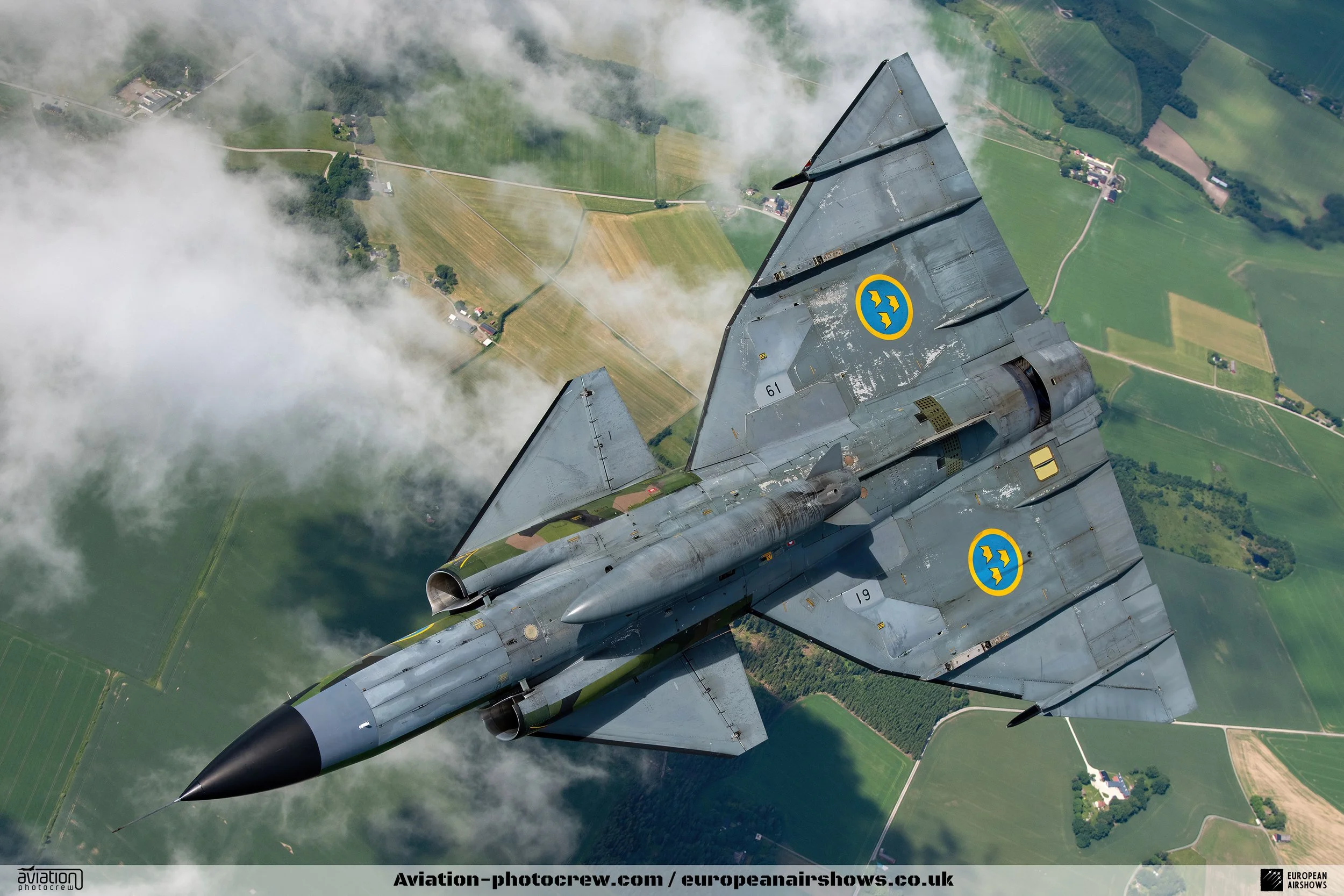
February 8 / Saab 37 Viggen first flight
First Flight 8 February 1967
Saab 37 Viggen
The Saab 37 Viggen, known as “The Tufted Duck” in Swedish, is a pioneering single-seat, single-engine multirole combat aircraft designed and manufactured by the Swedish aerospace company Saab. Notably, the Viggen was the first canard-equipped aircraft to be produced in significant numbers and marked a technological leap as it was the first combat aircraft to feature an airborne digital central computer utilizing integrated circuits for its avionics. This innovation rendered the Viggen one of the most advanced combat aircraft in Europe upon its introduction in the 1970s. The digital central computer, designated the CK 37, automated many tasks that previously required a navigator or co-pilot, significantly enhancing operational efficiency during high-speed tactical missions, a capability that was not surpassed until the introduction of the Panavia Tornado in 1981.
The development of the Viggen began in the early 1950s, initiated to create a successor to the Saab 32 Lansen in the attack role and the Saab 35 Draken as a fighter. The design team at Saab opted for a radical delta wing configuration, integrating the aircraft as a component of Sweden’s STRIL-60 national electronic air defense system. A significant design requirement was the aircraft’s ability to operate from short runways, as brief as 500 meters, which necessitated a robust design capable of handling short takeoff and landing (STOL) conditions. The development process was bolstered by the “37-annex,” an agreement that allowed Sweden to access advanced U.S. aeronautical technology, expediting both the design and production phases. The aerodynamic design was finalized in 1963, and the first prototype took to the skies on February 8, 1967. Following a successful maiden flight, the Swedish government placed an order for an initial batch of 175 Viggens, with the aircraft entering service with the Swedish Air Force on June 21, 1971.
As the AJ 37 model entered service, Saab continued to develop additional variants of the Viggen, including the SF 37 for aerial reconnaissance, the SH 37 for maritime patrol, and the two-seat SK 37 trainer. The most advanced variant, the all-weather interceptor/strike fighter JA 37, was introduced in the late 1970s. Despite efforts to export the Viggen to other nations, these attempts were ultimately unsuccessful. The Viggen remained in service exclusively with the Swedish Air Force until its retirement in November 2005, having been replaced by the newer Saab JAS 39 Gripen.
The name “Viggen” holds dual meanings in Swedish. It refers to the tufted duck, a species native to Sweden, which alludes to the aircraft’s canard configuration—“canard” being French for duck. Alternatively, “vigg” is connected to the term “åskvigg,” or “thunderbolt,” drawing from Nordic folklore that describes thunderstones believed to be created by lightning strikes from Thor’s hammer, Mjölnir. The dual significance of the name encapsulates both the aircraft’s innovative design and its formidable capabilities.
The Viggen was conceived as a replacement for the Saab 32 Lansen and the Saab 35 Draken, with the Swedish Air Force outlining a series of stringent requirements for the new aircraft. The development process, which began in earnest in the early 1950s, involved extensive studies and the examination of over 100 different concepts, including both single- and twin-engine configurations and various wing designs. The Viggen was envisioned as an integrated weapon system that could operate alongside the STRIL-60 air defense system, fulfilling multiple tactical roles with supersonic capabilities at both low and high altitudes, while also ensuring ease of repair and serviceability.
A notable requirement was the aircraft’s ability to take off and land on runways as short as 500 meters, a key aspect of the Bas 60 airbase system that the Swedish Air Force adopted in the late 1950s. This system emphasized the dispersal of aircraft across numerous wartime airbases, including the use of roadways as emergency runways. The design of the Viggen had to accommodate several critical factors, including modest landing speeds, effective braking systems, and high acceleration during takeoff, all of which contributed to its STOL capabilities.
In 1960, the U.S. National Security Council, under President Eisenhower, established a security guarantee for Sweden, which included military-technology collaboration. This agreement, known as the “37-annex,” facilitated Sweden’s access to advanced U.S. aeronautical technology, significantly accelerating the Viggen’s development. The Swedish government officially approved the development of Aircraft System 37 in December 1961, leading to the finalization of the aircraft’s design and the establishment of production contracts by the mid-1960s. The Viggen project became a monumental industrial undertaking for Sweden, accounting for a significant portion of the nation’s research and development funding during the 1960s.
The Viggen’s aerodynamic design was groundbreaking, featuring an aft-mounted double delta wing complemented by a small, high-set canard foreplane. This configuration was instrumental in achieving the necessary performance metrics, such as STOL capabilities and supersonic flight. The aircraft’s design continued to evolve, incorporating enhancements such as dog-tooth patterns on the wings to improve lift and maneuverability. The decision to power the Viggen with a single large turbofan engine led to the selection of the Volvo RM8, a heavily modified version of the Pratt & Whitney JT8D engine, which provided the necessary thrust for both supersonic flight and short-field operations.
The first prototype of the Viggen successfully flew in 1967, leading to the production of a total of seven prototypes, each serving distinct developmental roles. The Swedish government recognized the Viggen’s potential, determining that it would be both more cost-effective and superior to the McDonnell Douglas F-4 Phantom II. By April 1968, the Swedish government authorized the manufacturing of 175 Viggens, with the first production aircraft entering service in July 1971. As the AJ 37 model was introduced, additional variants continued to be developed, including operational trainers and reconnaissance models, culminating in the introduction of the all-weather interceptor variant, the JA 37, in the late 1970s.
Despite initial projections to produce over 800 Viggens, economic factors ultimately resulted in a total production figure of 329 aircraft. The Viggen’s operational life extended into the 1990s, during which a significant upgrade program was implemented to enhance its capabilities and ensure compatibility with modern munitions and avionics systems. The Viggen’s legacy endures as a testament to Swedish aerospace engineering, reflecting a unique combination of innovative design, advanced technology, and operational versatility.
Saab 37 Viggen Facts
Innovative Design: The Saab 37 Viggen was the first combat aircraft produced in significant numbers to feature a canard configuration, which enhances its aerodynamic performance and manoeuvrability.
Digital Avionics Pioneer: It was also the first aircraft to carry an airborne digital central computer utilizing integrated circuits for its avionics, making it one of the most advanced combat aircraft in Europe at the time of its introduction in the 1970s.
Short Takeoff and Landing (STOL): The Viggen was designed to operate from runways as short as 500 meters, allowing it to be deployed from various locations, including roads, as part of Sweden’s Bas 60 airbase system.
Multiple Variants: Several variants of the Viggen were developed for different roles, including the AJ 37 (fighter-bomber), SF 37 (reconnaissance), SH 37 (maritime patrol), and the JA 37 (all-weather interceptor), showcasing its versatility as a multirole combat aircraft.
Cultural Significance: The name “Viggen” has dual meanings in Swedish; it refers to both the tufted duck, symbolizing its canard design, and “åskvigg,” meaning “thunderbolt,” linked to Norse mythology and the god Thor.
Advanced Engine Technology: The Viggen was powered by the Volvo RM8 turbofan engine, a heavily modified version of the Pratt & Whitney JT8D, which was notable for being one of the first engines equipped with both an afterburner and a thrust reverser.
Significant Production: Although originally planned for production of over 800 units, economic factors ultimately limited the total number of Viggens produced to 329, with the last aircraft delivered in 1990.
High-Tech Cockpit: Viggen’s cockpit featured a mix of traditional analogue instruments and advanced digital displays, including a head-up display (HUD) and multi-purpose cathode-ray tube (CRT) screens, which were quite advanced for the time.
Enhanced Combat Capabilities: The JA 37 variant introduced in 1979 included advanced radar and missile systems that allowed it to engage targets at beyond-visual-range distances, significantly enhancing Sweden’s air defence capabilities.
Legacy and Replacement: The Viggen served the Swedish Air Force until November 2005, when it was replaced by the newer Saab JAS 39 Gripen, marking the end of an era for this iconic aircraft that played a crucial role in Sweden’s defence strategy.

















